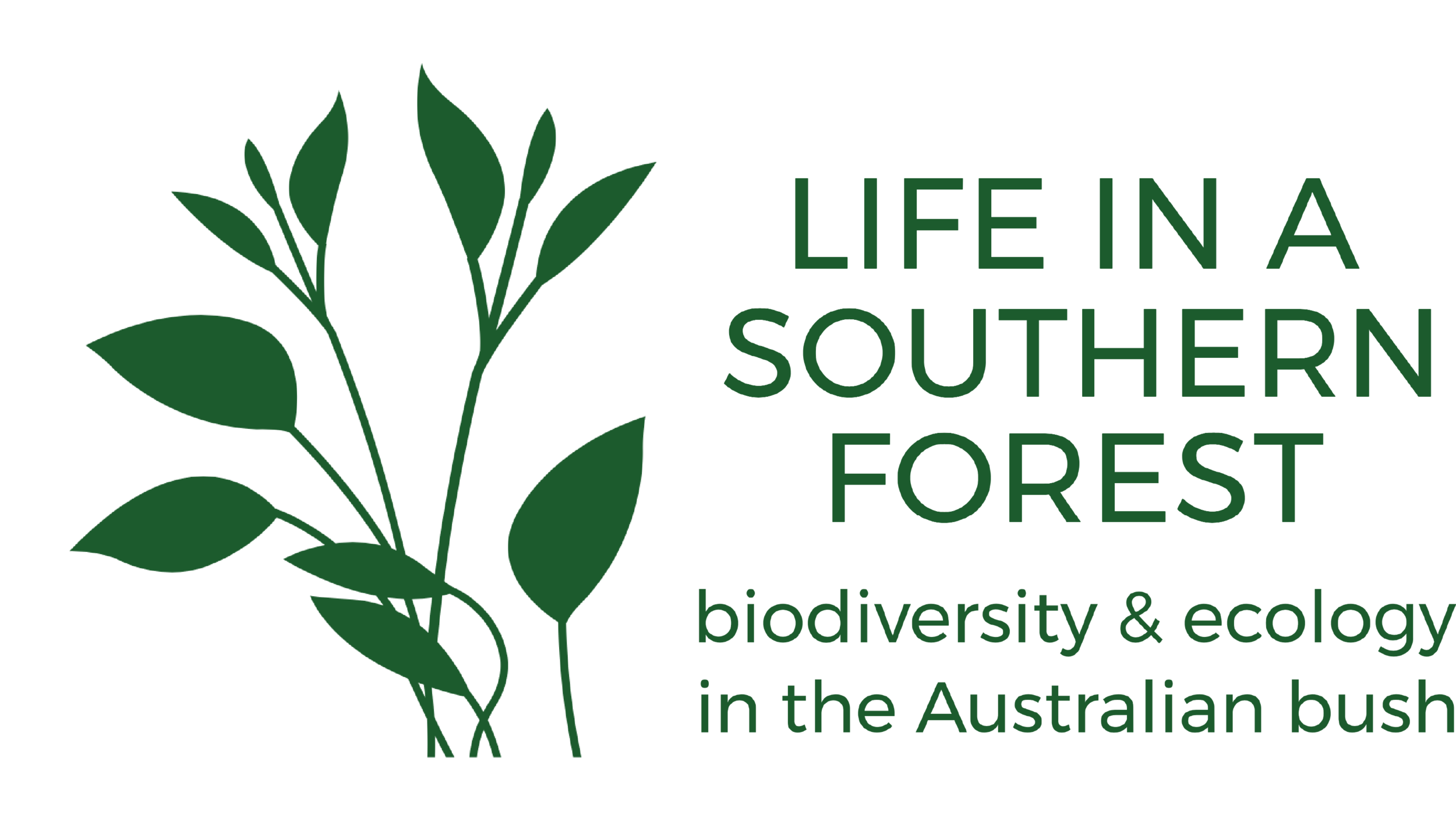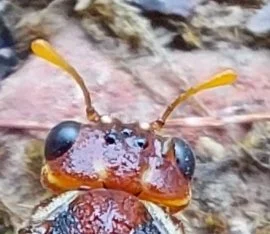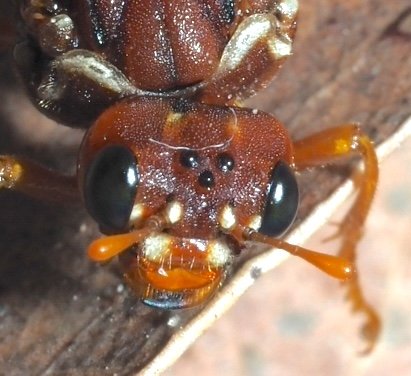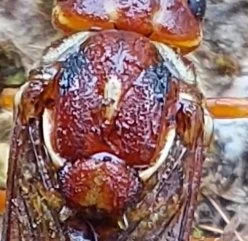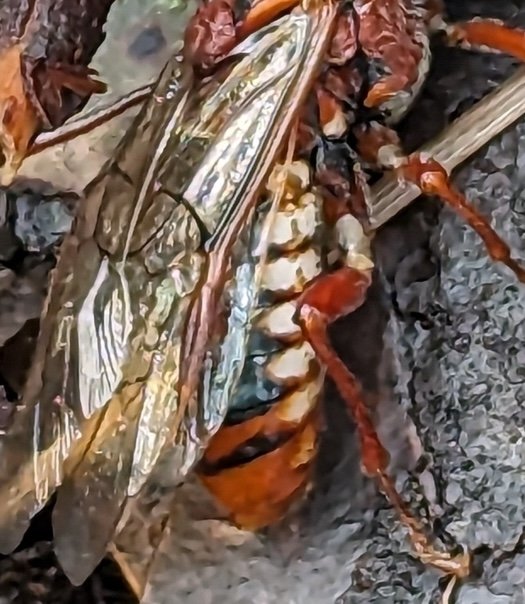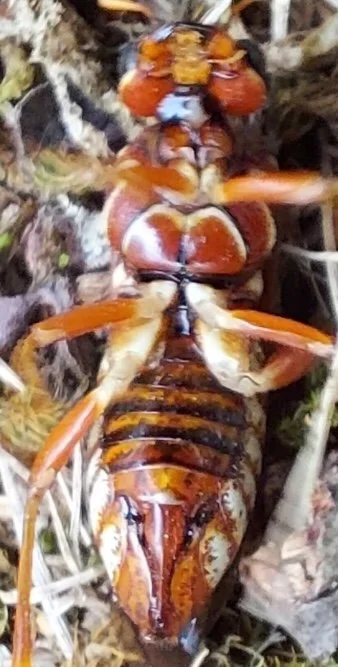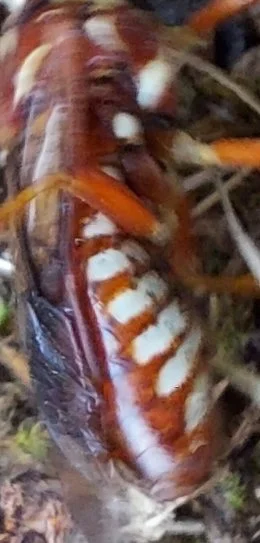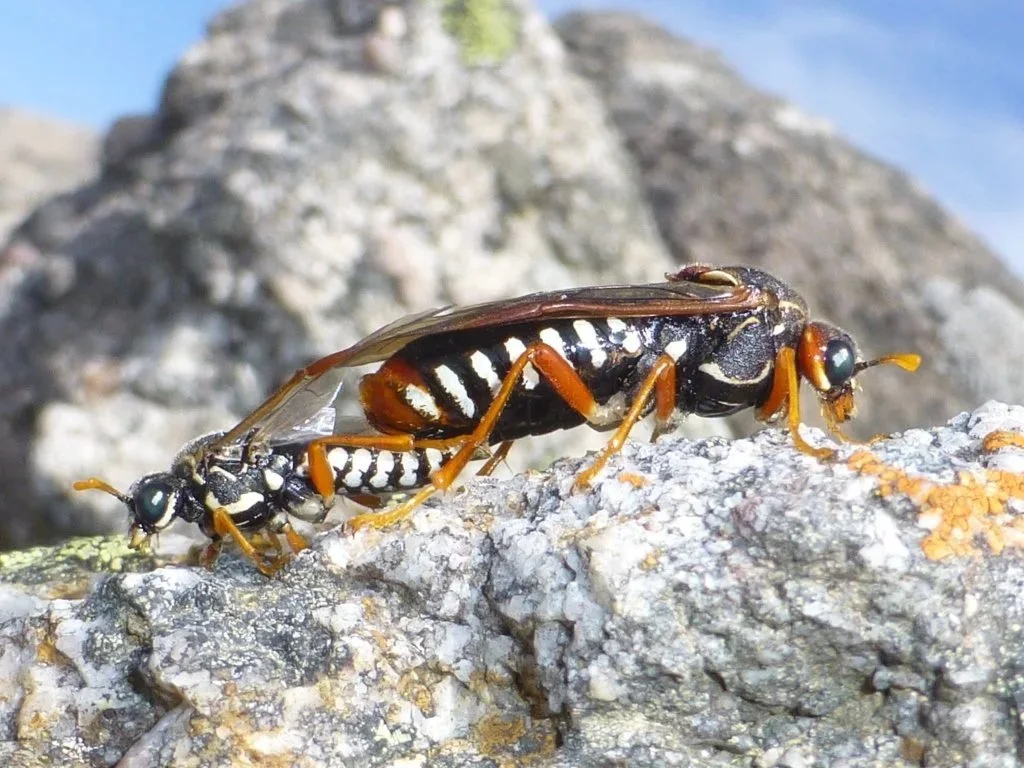Pergagrapta bella vs. turneri

Image above courtesy of Reiner Richter (iNaturalist observation) CC BY
Workbook
Can Pergagrapta bella and Pergagrapta turneri be distinguished in field photographs?
This task is complicated by the fact that there are 8 junior synonyms of P. bella, viz. Pergagrapta (Perga) bella (Newman, 1841), P. foersteri (Westwood, 1880), P. divaricata (Kirby, 1893), P. rubripes (Rohwer, 1910), P. montana (Forsius, 1935), P. nigra (Benson, 1939), P. rohweri (Benson, 1939) and P. rossi (Benson, 1939). An original description of the male is available for only two of these species - P. foesteri and P. divaricata while descriptions of the female are available for all species.
Morice synonymised P. divaricata and P. foersteri with P. bella in 1919, while Benson synonymised the others in 1939 and 1958.
There is one junior synonym of Pergagrapta turneri (Benson, 1939) - P. hackeri - which Benson himself synonymised in 1958. Both sexes were described for each of these species.
Benson (1958) states that after “seeing a long series of some of the species…I had underestimated the range of variation of some of them in 1939…and therefore submit new synonymy.”
Below, I show representative images from Research Grade iNaturalist observations of females identified as either Pergagrapta bella (32 females) or Pergagrapta turneri (25 females).
My aims are to:
illustrate variability in individual features of these species, particularly diagnostic characters
help determine whether those features match the original descriptions
decide whether and how P. bella and P. turneri can be separated in field photographs
In the following analysis, descriptions of each body part are taken from the original descriptions of the species, including junior synonyms.
Text in bold states whether or not RG iNaturalist observations agree with the description.
Pergagrapta bella/turneri females
Colour of antenna
Pergagrapta bella
flagellum yellow or yellowish-white with “basal joints blackening”- yes, scape and pedicel consistently black, together with the next antennomere or two in some cases; rest of flagellum uniformly yellow
Pergagrapta turneri
antennae yellowish white - yes, but pedicel and sometimes scape black; flagellum consistently yellow with basal segments brown in a few cases.
Colour and morphology of head
Pergagrapta bella
base colour - orange/testaceous (bella, foersteri), yellowish-brown (rossi, rohweri), reddish-brown/chestnut (divaricata, rubripes) or black (nigra) - yes, this whole range of base colours seen in different individuals
vertex with two lateral white spots (1 in first image below) - yes
white antennal tubercles (2 in first image below) - yes
creamy white inner and outer orbits (3 in first image below) - yes, but variable in extent
creamy white genae (4 in first image below) - yes
clypeus (5 in first image below) black or black with white lateral spots, yellowish-brown with white lateral spots, reddish-yellow with white margins, black with white hind margin - yes, all of these variants seen
labrum black or yellow (6 in first image below) - yes, but mainly yellow or orange
area behind ocelli with many fine punctures (except in P. rossi where sparsely punctured) - yes
area behind ocelli only very slightly raised above level of genae, lack vertical furrows - not or little raised in some cases (205457224, 201995062, 202780952, 165097001, 152712070, 112464793, 67697537); raised with a vertical furrow in others (203992689, 2039613322, 153431735, 163591836, 96043858, 82091610, 27686880)
Pergagrapta turneri
base colour - reddish-brown/chestnut (turneri, hackeri) - yes
yellowish-white vertical furrows (taken to mean vertex with two lateral white spots) - yes
yellowish-white antennal tubercles - yes
yellowish-white inner and outer orbits - yes
yellowish-white genae - yes
clypeus yellowish-white - yes, sometimes with orange patch
labrum yellowish-white - yes
area behind ocelli dense with punctures - yes
area behind ocelli raised above level of genae each side, about as long as broad, broadening slightly behind with a conspicuous longitudinal medial furrow (NB this can be assessed only in high resolution images) - raised with a vertical furrow in almost all cases (217837127, 209436252, 205298518, 200590751, 200503362, 161580276, 153429592, 151383695, 111717873, 108480821, 72062823, 42087086, 42087073); not or little raised in just a few (55489020, 27678511).
Colour of pronotum
Pergagrapta bella
yellowish-brown, red or black - with creamy white hind margin - yes, all variants seen
Pergagrapta turneri
chestnut in lower front half with posterior half yellowish white (P. turneri) or entirely yellowish-white except for a chestnut spot in middle front portion (P. hackeri) - the P. turneri pattern is evident in iNat observations, but it is unlikely that these individuals are P. turneri as that species was collected in Northern Queensland (Mackay and Cairns). None of the iNat observations show the pronotum colour of P. hackeri.
Mesoscutum and scutellum colour and morphology
Pergagrapta bella
mesoscutum heavily punctate; middle lobe with central furrow, black or reddish-brown with rear portion a yellowish-white droplet; front portion or all of lateral lobes black - yes, this range of colours seen in different individuals.
scutellum with shallow medial furrow, making midline slightly concave; broader than long, almost square; with obtuse hind lobes; irregularly but thickly punctured; colour ranges from yellow-orange to dull rufous to yellowish-brown; sometimes with a creamy-white patch in the middle - yes, consistent morphology with this range of colours seen in different individuals
yellowish-white extensions from the front corners of the scutellum course along the lateral edges of the mesoscutum - yes, seen in all cases
Pergagrapta turneri
mesoscutum reddish-brown/chesnut with hind portion of middle lobe yellowish-white; side lobes with sparse punctures, except in front of scutellum where punctures are dense - yes, same colour but no clear indication that side lobes have fewer punctures
scutellum with sparse vague punctures; broader than long with well developed hind lobes; a very deep medial furrow, deepening and broadening behind; colour reddish-brown with front 2/3rds yellowish-white - overall shape matches, but wrong colour and medial furrow is not obviously deeper than in P. bella
yellowish-white extensions from the front corners of the scutellum course along the lateral edges of the mesoscutum - yes, seen in all cases
Abdomen colour
Pergagrapta bella
dorsum all black or yellowish-brown with dorsal patches of terga 2-6 black - yes all of these variations seen
creamy-white lateral patches on terga 2-8 - yes consistently present
venter yellowish-white or black or part black and reddish-brown - yes all of these variations seen
Pergagrapta turneri
reddish-brown; a small lateral yellowish-white spot behind the stigma on the side of each tergum - uniform reddish-brown/chestnut colour seen on dorsum (although wings obscure view of dorsum) and venter but also large lateral white patches, not matching the original description of small yellowish-white spots behind the stigmata
Leg colour
Pergagrapta bella
all coxae white or orange - no, either orange or black basally and white apically
all femora orange, reddish or reddish-yellow - yes, consistently
all tibiae and tarsi orange or reddish - yes, consistently
Pergagrapta turneri
all coxae and femora reddish-brown - yes
fore and mid tibiae yellowish-white, hind tibiae with apical 1/4 chestnut and basal 3/4 yellowish-white (this colour difference barely apparent in P. hackeri, the south-eastern variant) - no, all tibiae are uniformly reddish-brown
tarsi yellowish-white in all legs - no, all tibiae are consistently reddish-brown
Pergagrapta bella/turneri males
Note that there are original descriptions of type specimens for only two of the synonymised P. bella species, viz. P. foersteri Westwood and P. divaricata Kirby.
Westwood (1880) provides this drawing of the male of P. foersteri.
Benson (1939) states that the males of both P. turneri and its junior synonym P. hackeri are like the females, apart from having a male-specific scaly patch on the underside of their forewings beneath the stigma.
He provides no further details of their morphology.
Pergagrapta foersteri Westwood (1880), Pl. 36, Fig. 1
James Peake has now established that of the males previously identified as Pergagrapta bella/turneri on iNaturalist are in fact males of Pergagrapta latreillii. They match the descriptions in the literature closely.
Roger Farrow has photographed Pergagrapta bella males and females in copula during a hill topping event in Wadbilliga NP - see below. The male is similar to the Pergagrapta latreillii male, except for the colour of the abdomen. In P. latreillii, the whole abdomen is orange/chestnut brown, whereas in P. bella it is black with white lateral stripes in every segment and white stripes on the venter which alternate with the lateral white stripes. This matches the descriptions and drawing of P. foersteri (Westwood) and description of P. divaricata (Kirby), which Benson (1939) synonymised with P. bella.
There are no apparent iNaturalist observations of the male P. bella. They may only appear during hill topping events when large numbers of females gather.
Distribution of iNaturalist observations of P. turneri and P. bella
Summary and conclusions
iNaturalist observations of many females match the original descriptions of Pergagrapta bella and its junior synonyms in all details, bearing in mind their wide variation in colour.
No males matching the original description of P. bella or its junior synonyms have been found in iNaturalist observations. It has been established that the males previously identified as P. bella are in fact P. latreillii.
No iNaturalist observations of either females or males from south-eastern Australia match the original description of P. hackeri, the junior synonym of P. turneri which was collected from that region.
iNaturalist RG observations of P. turneri females show the background chestnut body colour originally described for P. turneri/hackeri. However, the same colouration is shared with some of the variants of P. bella (e.g. P. rubripes, P. rossi, P. rohweri). So a chestnut colour is not by itself sufficient to separate this species from P. bella.
From Turner’s original descriptions of P. turneri/hackeri, at least four characters separate that species from P. bella:
The post-ocellar region is raised above the genae on each side and has a conspicuous longitudinal midline furrow. This is a relatively subtle feature that can only be seen in high resolution photos.
The pronotum of P. hackeri, the south-eastern variant, is entirely pale (whitish-yellow) except for a chestnut spot at the front.
The scutellum of P. turneri/hackeri is reddish-brown with front 2/3rds yellowish-white.
The abdomen of P. turneri/hackeri is reddish-brown with a small lateral yellowish-white spot behind the stigma on the side of each tergum.
While many iNaturalist RG observations currently identified as P. turneri show feature #1, it is also seen in some RG P. bella observations. None of these RG observations of P. turneri show features #2, 3 or 4.
I conclude that the species ID of these observations should be changed to P. bella.
References
Benson, R.B. 1939. A revision of the Australian sawflies of the genus Perga Leach, sens. lat. (Hymenoptera, Symphyta). The Australian Zoologist 9: 324-357.
Benson, R.B. 1958. On some Pergine sawflies reared by Mr M. F. Leask (Hymenoptera, Pergidae). Proceedings of the Linnean Society of New South Wales 83: 288-290.
Kirby, W.F. 1893. Descriptions of five new species of Australian saw-flies. Annals and Magazine of Natural History (6) 12: 38-43.
Newman, E. 1841. “Supplement” to notes on the entomology of Adelaide, South Australia by A.H. Davis. Entomologist 1: 89-90.
Rohwer, S.A. 1910. Some Australian sawflies. Entomological News 21: 467-474.
Westwood, J.O. 1880. A monograph of the sawflies composing the Australian genus Perga of Leach. Proceedings of the Zoological Society of London 1880: 359-379.
This is a workbook page … a part of our website where we record the observations and references used in making species identifications. The notes will not necessarily be complete. They are a record for our own use, but we are happy to share this information with others.
